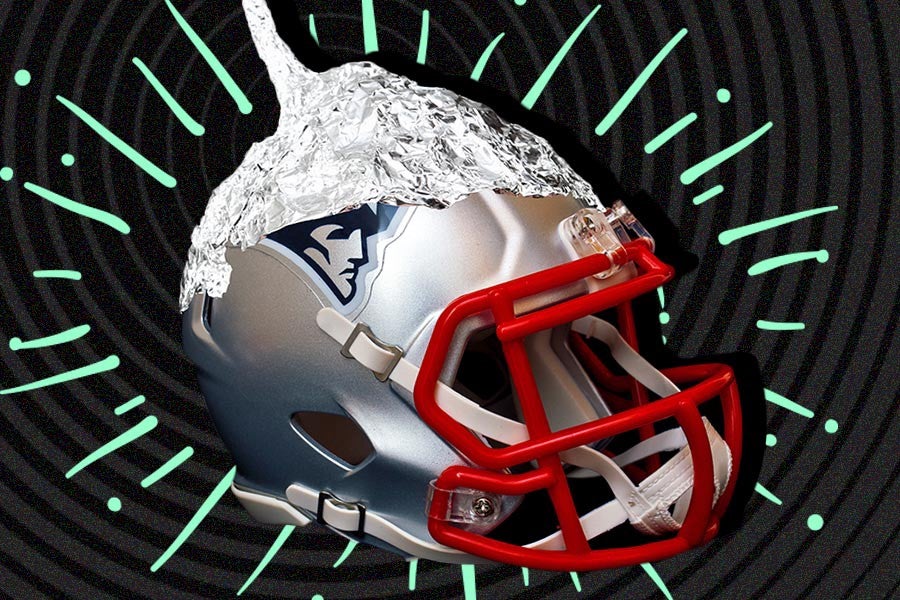Brian Tuohy can’t prove the NFL is fixed, but he’s convinced it’s the truth. “I’m certain of it,” Tuohy tells me with a confidence only a conspiracy theorist can conjure.
What most fans dismiss as quirky plays, missed calls and statistical anomalies, Tuohy sees as evidence of the NFL’s corruption. “We see bizarre [referee] calls and bizarre plays and think, It’s just one of those things,” Tuohy explains. “Well, I don’t think it’s just one of those things. I don’t believe in coincidences, especially when it’s a multibillion-dollar company calling the shots.”
Touhy became the de facto leader of the NFL truther movement in 2010 when he published The Fix Is In, a book about rampant corruption in professional sports published by Feral House, a publisher known for trafficking in fringe subject matter. “The same day my book was released, they also released The Unabomber’s Manifesto,” he says. (For the record, Tuohy bristles at being called a “conspiracy theorist,” a term conspiracy theorists generally regard as part of a conspiracy theory aimed at diminishing their theories.)
The Fix Is In covered how each of the professional sports leagues manipulates games to increase television ratings, and in turn, their popularity and revenues. Since then, Tuohy has kept a blog of the same name, chronicling the many ways in which the NFL has controlled the outcomes of games and deceived its fans into thinking they were watching “pure” competition.
One piece of his evidence: The Green Bay Packers went 15–1 in the 2011 regular season, one win shy of a “perfect” record. But Tuohy points out the Packers didn’t have a single offensive holding call made against them in 11 straight games that season. Holding can be called on just about every play in an NFL game, so for it not to be called against one team for that many games is more than mere coincidence, argues Tuohy. It was, in his estimation, part of a coordinated effort to vault young Packers quarterback Aaron Rodgers to superstardom.
“The NFL sees certain storylines start to develop, and then says, ‘This guy is national news. What if we give him a little help here and there and extend this storyline longer than it should naturally go?’” Tuohy posits. “Suddenly a team that was supposed to be 8–8 is 10–6 and in the playoffs — and isn’t that good for everyone?”
The NFL concocted a similar plot last year, he says, with the Dallas Cowboys and their rookie quarterback Dak Prescott, who more or less ended Tony Romo’s career with his stellar play, and with Tim Tebow when he made an improbable postseason run with the Denver Broncos in 2011. Sometimes the league interferes with individual calls, Tuohy says, such as Calvin Johnson’s infamous non-catch against the Chicago Bears in 2010. (The Bears would go on to win the division. Hmm.) Or when Dez Bryant suffered from a similar call in the 2014 playoffs. (Against the beloved Packers, no less. Interesting.)
“[The definition of a catch] is one of the gray areas the NFL can exist in,” Tuohy says. “The official could have come back on the field and said it was a catch because of A, B or C in the rulebook. Instead, he came back on the field and said it wasn’t a catch because of X, Y and Z. The rules are so gray in this area that it lets the league manipulate the game right in front of its fans. I don’t think it’s bad officiating. It’s intentional.”
Similarly, he believes this past Super Bowl, which is widely considered to be the greatest comeback in the history of the NFL, if not all of televised sport, was also rigged. “To me, that was a script taken directly from professional wrestling, right down to Roger Goodell handing the trophy over and getting booed off the field,” Tuohy says. (In wrestling parlance, Goodell was a major heel vis-á-vis the Patriots for suspending quarterback Tom Brady for the first four games of the season — and for a crime many believe he didn’t commit or that Goodell couldn’t prove.)
Tuohy points out that the NFL is under no legal obligation to ensure a fair game. The games the league provides are entertainment, and it can produce that entertainment anyway it pleases.
As proof, Tuohy cites more than 400 FBI files he secured under a Freedom of Information Act request for his second book Larceny Games. The files show the Bureau was investigating rampant gambling corruption in the league in the late-1960s and 1970s. That said, the Bureau was never able to bring criminal charges.
“Oh, God yes, it [still] happens,” San Diego–based journalist Don Bauder, a fellow NFL truther, says of Sunday point-shaving. Bauder first started covering the NFL in 1964 as a reporter at Businessweek. He left the job for the San Diego Union-Tribune, where he served for years as the paper’s finance editor and finance columnist. He retired in 2003, and now keeps a blog hosted by the San Diego Reader alt-weekly.
At its founding, the NFL was financed by mobsters who had an interest in making sure games went a certain way, Bauder says. The gambling persisted, he alleges, until the 1980s, only subsiding once player salaries started to skyrocket and throwing games was no longer worth the risk for them.
Still: “I don’t think it goes on as much as it did in the past, but I’m sure it does happen,” he argues.
As proof of their beliefs, both Bauder and Tuohy could only speculate on possible scenarios and offer circumstantial evidence. They remain undeterred nonetheless. “People say, ‘Prove it.’ I’m sorry, I can’t prove it,” Tuohy says. “But if [game fixing] has happened once in the past five years or 10 years, because the league wants to further a certain story line, then the league has no integrity.
“All I have to do is be right once, and then I’m right across the board.”
